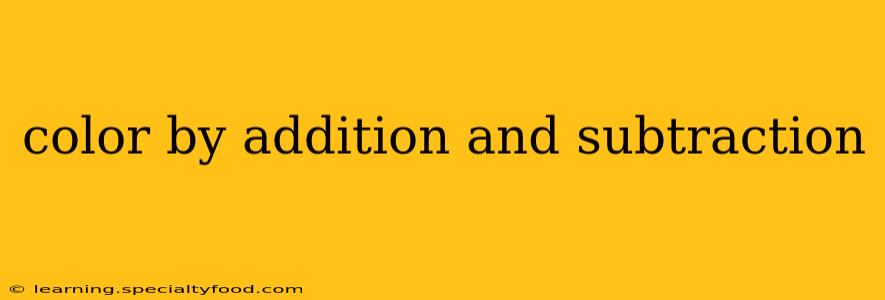Color mixing is a fundamental concept in art, design, and even science. Understanding how colors interact is crucial for achieving desired results, whether you're painting a masterpiece, designing a website, or understanding how a TV screen works. This exploration delves into the two primary methods of color mixing: additive and subtractive.
What is Additive Color Mixing?
Additive color mixing is the process of combining different colored lights to create new colors. The primary colors in additive mixing are red, green, and blue (RGB). When these three colors are combined at their maximum intensity, they produce white light. This system is used in digital displays like computer monitors, televisions, and smartphones.
How Does Additive Color Mixing Work?
Imagine shining a red light and a green light onto a white surface. Where the two lights overlap, you'll see yellow. Combining red and blue creates magenta, while green and blue create cyan. Adding all three together results in white. This is because the lights add their wavelengths together. The more light sources you combine, the brighter the resulting color becomes.
Examples of Additive Color Mixing
- Television screens: Pixels on a screen are tiny lights that emit red, green, and blue light. The combination of these lights creates the millions of colors we see on our screens.
- Stage lighting: Stage lighting often uses RGB lights to create a vast array of colors for theatrical productions.
- Digital photography: Digital cameras capture light information using RGB sensors, converting light into digital data to form the image.
What is Subtractive Color Mixing?
Subtractive color mixing is the process of mixing pigments or dyes to create new colors. The primary colors in subtractive mixing are cyan, magenta, and yellow (CMY), sometimes with black (K) added to improve the depth of darker colors (CMYK). This system is used in printing, painting, and other applications where physical materials are combined.
How Does Subtractive Color Mixing Work?
In subtractive mixing, pigments absorb certain wavelengths of light and reflect others. For instance, cyan pigment absorbs red light and reflects green and blue light. When you mix cyan and magenta pigments, the cyan absorbs the red light, and the magenta absorbs the green light, leaving only blue light to be reflected. Therefore, mixing cyan and magenta results in blue.
Examples of Subtractive Color Mixing
- Printing: Printers use CMYK inks to produce colored images on paper. The inks absorb light, and the reflected light creates the colors we see.
- Painting: Painters mix pigments to create a wide range of colors. The more pigment added, the darker and more saturated the color becomes.
- Dyeing fabrics: Dyeing fabrics uses subtractive color mixing principles to create colored textiles.
Additive vs. Subtractive Color Mixing: Key Differences Summarized
| Feature | Additive Color Mixing (RGB) | Subtractive Color Mixing (CMYK) |
|---|---|---|
| Method | Combining lights | Mixing pigments or dyes |
| Primary Colors | Red, Green, Blue | Cyan, Magenta, Yellow, Black (K) |
| Combined Result | White | Black |
| Applications | Computer screens, televisions, stage lighting | Printing, painting, dyeing fabrics |
Frequently Asked Questions (FAQs)
What are the secondary colors in additive and subtractive color mixing?
In additive mixing, the secondary colors are cyan (blue + green), magenta (red + blue), and yellow (red + green). In subtractive mixing, the secondary colors are red (magenta + yellow), green (cyan + yellow), and blue (cyan + magenta).
Why is black added to CMY to make CMYK?
Adding black (K) to CMY improves the accuracy and depth of dark colors in printing. Mixing cyan, magenta, and yellow often results in a muddy, dark brown rather than a true black. Black ink provides a sharper, more defined black, and reduces the amount of other inks needed, saving costs and improving print quality.
Can I use additive and subtractive color mixing techniques together?
While not directly combined, the principles influence each other. Understanding both systems is vital for accurate color representation in digital design and print reproduction. For example, a designer creates a digital image in RGB (additive), then needs to translate those colors accurately into CMYK (subtractive) for printing, ensuring color consistency between the digital and printed versions.
Is there a way to perfectly match colors between additive and subtractive systems?
Perfect color matching between RGB and CMYK is often challenging due to the inherent differences between the two systems. Specialized software and color profiles help minimize the discrepancies, but some color variations are usually unavoidable.
This comprehensive guide offers a solid foundation in understanding additive and subtractive color mixing. By grasping these core concepts, you'll gain a better appreciation for the science and art behind color and its applications.
